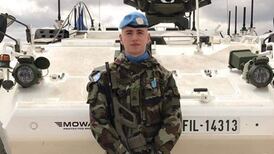So how do you save a life? If you ask my brother, it’s very easy. Twenty years ago I was first diagnosed with focal segmental glomerulosclerosis (FSGS).
FSGS affects the glomeruli in the kidneys, the tiny veins that do the all important filtering work. There’s not much that can be done with FSGS – there’s currently no cure, so it’s a case of managing it by keeping blood pressure low and taking medication.
I did that, but as the years went by my kidneys slowly wasted away.
This continued until 2012, when my kidney function reached just 15 per cent, the point where I began the process of trying to get on the transplant list before I suffered full kidney failure.
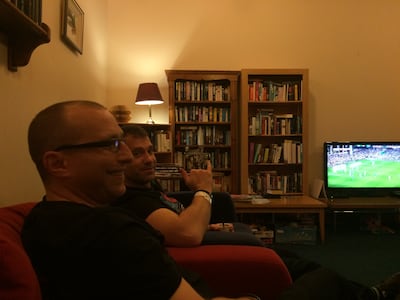
It’s a full battery of tests and during these an ultrasound revealed I had a cyst on one of my kidneys. A biopsy confirmed the news wasn’t great. Within a week I had the kidney removed and a biopsy revealed it was a small “clear” cancer which had been caught very early.
In a normal person they would just remove the lump, but in my case the whole kidney had to come out. This was because in the event of a possible future kidney transplant I would have to be completely cancer free as the immuno-suppressants I would have to take would cause any cancer to thrive.
Most kidney cancers are not discovered at all until it’s too late, so it was a lucky break, although it didn’t feel like it at the time.
It meant I would have to wait at least two years to get the all-clear before trying to go on the transplant list.
Now with just one (pretty badly) functioning kidney, my life changed massively. It was always at the back of my mind, as I had 14 years to get used to the prospect of kidney failure, but for my girlfriend Mary it was a lot to deal with very quickly. Thankfully, she was, and is, my incredible support through everything that was to come.
I had to go on dialysis much sooner than I had hoped. I began travelling into hospital three times a week for haemodialysis through a tube in my chest for the first two months – it’s usually done via a fistula in the arm, but as everything happened so quickly I had an emergency port in my chest.
Dr Phil
Later, I began peritoneal dialysis at home. This took about nine hours every night – Mary and I got used to the sounds of Dr Phil (the name we gave the dialysis machine) with the help of earplugs, although the occasional alarm would wake us with a start.
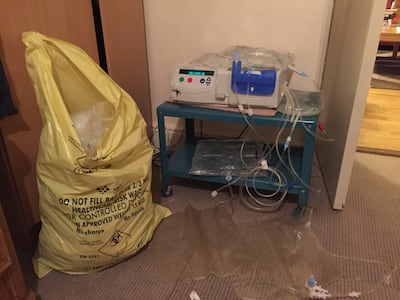
It involved having six litres of saline fluid pumped into and drained from my abdominal cavity over the course of every night, whilst I also carried around 1.5 litres in my abdomen during the day.
As well as Dr Phil (who was the size of an early 1980s’ video recorder), dialysis involved a massive amount of medical supplies being delivered to our apartment. Everything had to be kept sterile; I had to clean the catheter going in to my stomach and change the dressing daily to keep off infection.
The old supplies were dumped after use in a big yellow medical waste bin which was an object of fascination for our neighbours.
Any overnight stay meant either carting large boxes of liquid and supplies with us or having stock delivered to our destination. I maintained stockpiles in my parents and in-laws in Monaghan, along with a small cache when we managed a trip to visit friends in London.
I also had to follow a renal diet. A lot of it is healthy eating, but it’s mainly avoiding food high in phosphorus, potassium and protein.
It meant no more nuts, peas, mushrooms, beer, wine, coffee, tomatoes, brown bread, prawns or spinach among many random things I couldn’t eat. It meant limited servings of fruit, veg and dairy. It meant a lot of checking menus online before maybe going out and then a lot of questioning of waiting staff about hidden ingredients. It meant a lot of special requests when visiting friend(s) and family for meals, or just bringing my own food.
I also had to watch my liquid intake, limiting myself to three litres a day of all liquids including water, tea, soup – even ice cream or jelly.
So this became our new normal as I began the hopeful wait to get on the transplant list. We got used to the diet and things like going to bed earlier than anyone else on the night of my sister’s wedding so I could get my nine hours of dialysis in.
The incredible renal team at St Vincent’s always stressed it was important to keep living your life. I kept working, I asked Mary to marry me with the hope I would be able to enjoy our wedding day with a working kidney and without having to connect to Dr Phil.
After the two years, I began the X-rays, ultrasounds and blood tests once more. This time there were no complications and I was accepted on to the transplant list in January 2015.
When the possibility of a transplant was first raised, Mary and my immediate family all volunteered to be tested to see if they were a match. Now that I was on the list, my younger brother Geoff went forward without a second’s doubt. It turned out we were a very strong match.
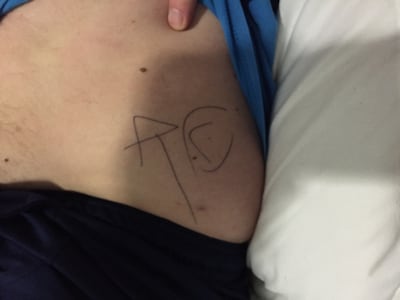
As a possible donor, Geoff drove the whole process; he made all the running. He aced all the tests, both physical and mental, surprising even himself with his clean bill of health. The transplant co-ordination team at Beaumont hospital were incredible every step of the way. If Geoff felt uncomfortable at any stage, he could pull out; I would be told there was a medical issue.
But he’s steadfast, he wanted to do this.
We kept waiting for a complication, something to go wrong. But nothing did, and we were given a date: March 30th.
The time from when I officially went on the list to the operation was 4½ months. A quick process after a very long wait. Our surgeons Gordan Smith and Dilly Little are reassuring and confident everything would be okay.
Everyone is nervous
We both check in the night before.
All is calm. To the staff on the renal ward it’s an everyday occurrence. Everything is explained again and again. We are put in separate rooms. Everyone is nervous, but for my parents (and my mum in particular) it’s even worse. It’s both of their sons who are going under the knife. My sister is in South America waiting on any news as well.
It all begins early the next morning.
We are prodded and poked and hooked up with needles. Geoff goes down to the theatre first. Once they are sure everything is okay I’m brought down to the theatre next door.
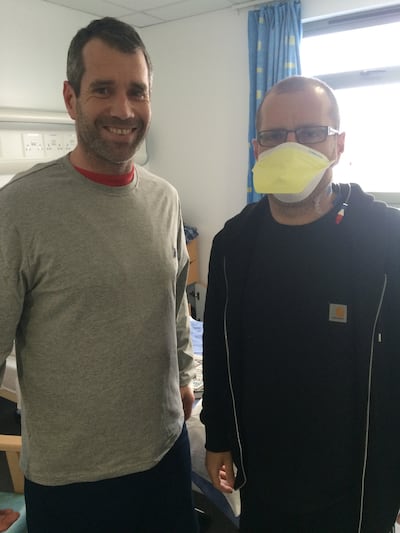
A mask is put on my face, I feel light-headed and then bam, Mary is in front of me. It’s all over. The surgery has taken five hours. I’m out of it thanks to pain medication, but I already feel better. I look down at the catheter bag. It’s full of urine. It’s worked. But I knew that as soon as I woke up.
I’m woken every hour for tests, but I don’t get to see Geoff until the next day. He’s up and walking before me and we manage to gingerly (due to catheters and tubes) share an embrace.
He’s changed my life.
Four months later, Mary and I are married.
Geoff is my best man. He had that job before we knew he was a match – and he’s there beside me on the best day of the rest of my life.
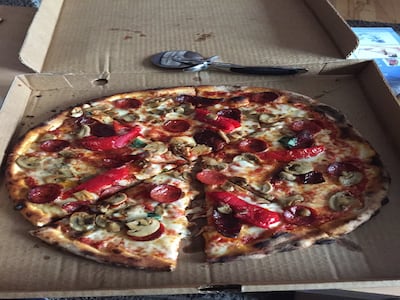
I celebrate my third “kidnaversary” on March 30th in full health thanks to my brother. I was lucky he was willing to be my hero and that he was such a good match.
Others can be heroes as well.
Just carry a donor card and have the talk with your own loved ones.







